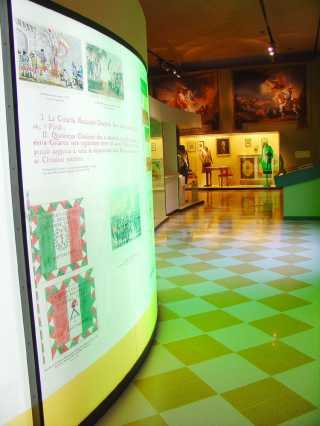

The Reggio City Hall is located in part at the beginning of via Toschi, to the south of the city’s main piazza which is dedicated to Camillo Prampolini. The building has a composite appearance due to the progressive adding on of new parts to the building.


Statue of Marco Emilio Lepido
The date engraved in a block of sandstone, to the right of the via Farini arch, reminds us that construction of the building began in 1414. The part facing the south side of the piazza was completed in 1417. City Council began holding its activities there in 1434, following construction of the vaults on via Farini and via Croce Bianca. In keeping with tradition, it seems that the external loggia underneath was also used for meetings. In following years, the city offices were enlarged. In 1583, a radical architectural restructuring was carried out by Prospero Pacchioni. Finally, the façade was rebuilt in 1774, embellished by three arcades with coupled piers, based on designs by Ludovico Bolognini. The City’s coat of arms lies below the roof cornice. A number of the halls inside are adorned by frescos from the 1700s and paintings from the 1800s.
Sala del tricolore (Tricolor Hall)
Designed and carried out by Bolognese architect Ludovico Bolognini in 1774, the hall was initially conceived of as the City archives.

Tricolore Hall, 1774-75, designed by Ludovico Bolognini
On 7 January 1797, representatives from the free cities of Reggio, Modena, Bologna and Ferrara met within this hall to proclaim the Cispadane Republic, adopting on this occasion the green-white-red tricolor flag, later adopted as the national flag in 1848 by King Charles Albert. The Tricolor Hall, which represents the city’s civic commitment, currently functions as the seat of the City Council. Also held in the Tricolor Hall is the city’s gonfalon, adorned with a gold medal. One side shows a portrayal of the Madonna of Ghiara with Saints Prosper, Grisanto, and Daria, while the other side bears the City’s coat of arms.
Tricolore Museum
Near the Bordello (Brothel) Tower (built in 1489 and so named for the brothel located nearby), the part of City Hall overlooking via dei Toschi has been set up as a museum, exhibiting documents and mementos from the period between the Reggian Republic of 1796 and the revolts of 1831.

Museo del Tricolore, hall

Museo del Tricolore, hall

Museo del Tricolore, hall

Museo del Tricolore, hall
The museum holds a wooden model of the Tricolor Hall dated 1773-74, built by carpenter Giovanni Benassi based on Bolognini’s design.

Museo del Tricolore, hall